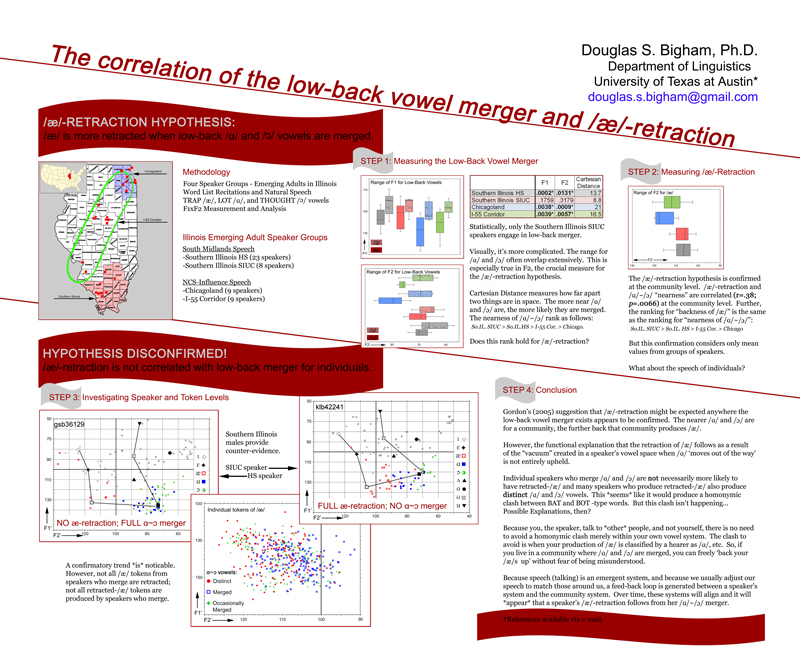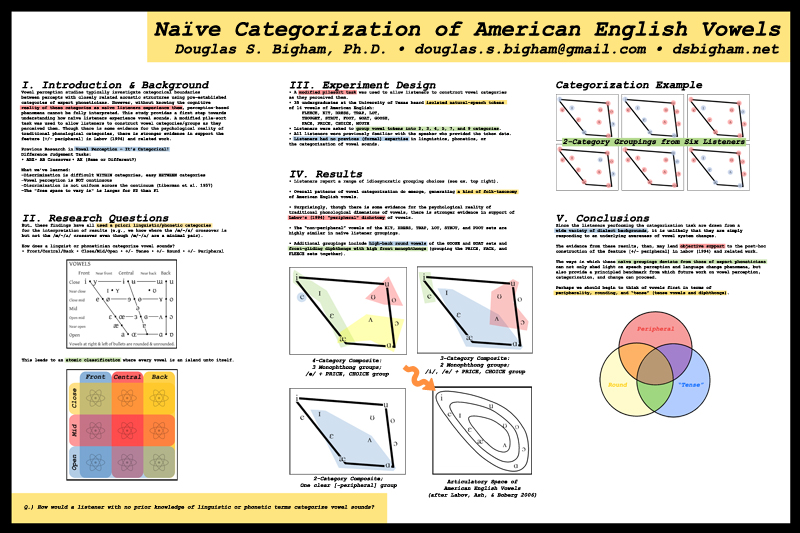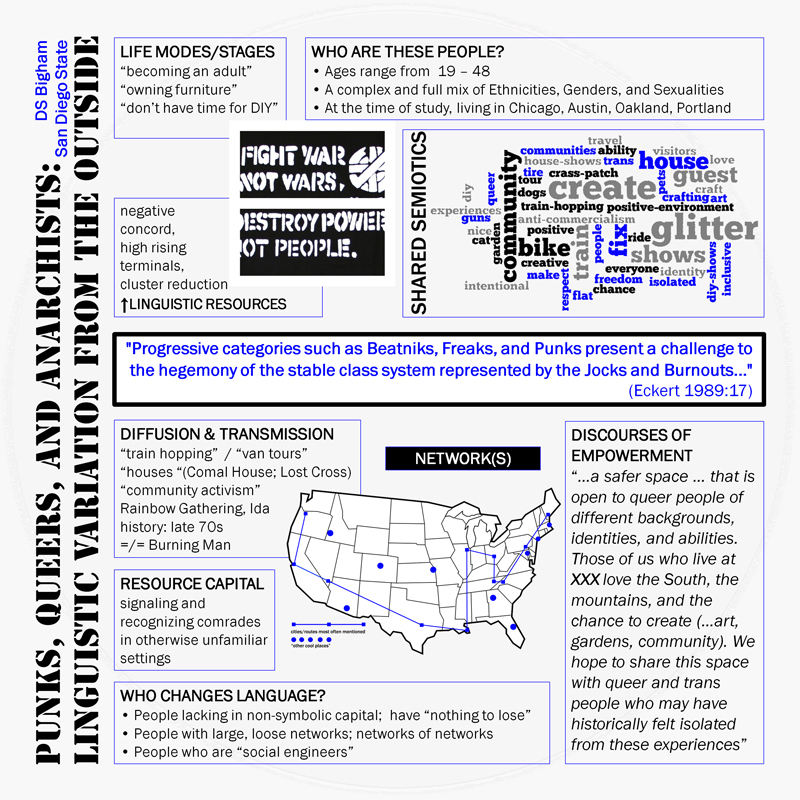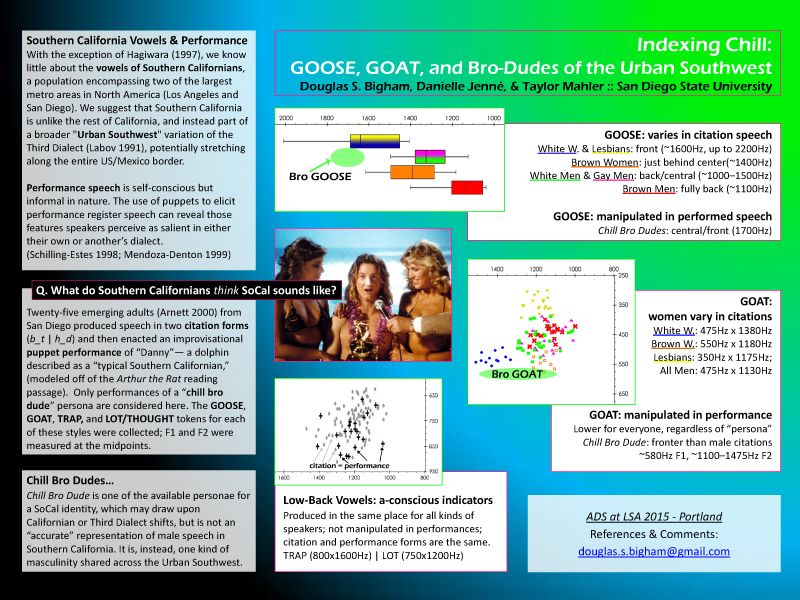More than "just teaching"
My portfolio showcases that in my years as a professor, I've done far more than "just teaching". In addition to the experience I've gained with the design hacks presented here, I grok multiple programs, UIs, languages, and settings and I have extensive experience in UX Design & Creative Strategies, Marketing, Product & Project Development, Survey Design & Analysis, and, of course, Instructional Design & Training. See my resumé for details.
Academic Posters as Wireframe Design
The notion of "wireframing" in design shares a lot in common with the idea of a poster presentation in acdemia. For acdemics, posters must not only be well-designed
and eye-catching-- drawing fellow researchers to your poster amid a sea of distractions from competetors, old friends, and free wine-- but they must also be conclusive and information-dense.
An academic poster should explain your research without much input from you, guiding the reader/viewer's attention in a logical progression from section to section
to build the story of your work, but also allowing for skimming of the independent modules (e.g., "background", "methods", "results", "conclusion") for the sake of time and attention span.
Below are five of the research posters I've designed for academic audiences; click on the thumbnails to see the work in full at my Academia.edu page.
(Also, #humblebrag, but if you look closely at the "Queers, Punks, and Anarchists" poster, you can see that I faded out a circle around the entire poster to mimic a record album sleeve. ha!)





WordPress for Education
I use WordPress in educational settings for front-end class and research websites and as a CMS course-materials and student-project management replacement for university-adopted bloat-engines like Blackboard and Tracks.
San Diego Speaks! is the main site for my reearch into the dialects of English and Spanish in San Diego County. Using the Quill theme as a baseline, I've encorporated several plugins and tinkerted with bits of the code to create a dynamic site that is both (1) a research database for managing field recordings and research projects across multiple researchers and grad students, and (2) a public-facing website for describing our work and encouraging participation from community members in San Diego County. I'm especially please with the integration of the GIS component on the "San Diego sounds like..." page and the recordings submission option on our "Say Hello!" pages.
LING 101 for SDSU functions as an interactive syllabus, supplemental textbook, and CMS replacement for my "Intro to Lingusitics" course at San Diego State University. The LING 101 website uses the DISCUSSION theme, fairly unmodified, along with basic Twitter, Tumblr, and YouTube modules. This site works as a CMS for over 45+ students in conjunction with a traditional classroom setting (Spring 2015) and as a guide for a fully online asynchornous course (Summer 2013, Spring 2016). I'm currently re-developing this site as a stand-alone theme for educators, using WordPress's own _s (Underscores) package.
Although now inactive for over four years, Popular Linguistics Magazine used a highly edited version of the Piano Black theme and acted as a monthly digital magazine, a kind of Scientific American for linguistics and language research. I was both editor-in-chief and lead web developer while it existed and, although it unfortunately shut down after only two issues, "Popular Linguistics" was also to act as a WordPress-empowered template for an interactive digital textbook, scalable for high school to college -level students.
Instructional Design
Part of good instructional design includes engaging lecture-style materials. Going beyond the typical Camtasia Capture, my Popular Linguistics video series on YouTube acts as both a refresher course for students in a traditional classroom and as the main component of asynchornous online learning. The short and fun lectures are especially geared toward adult learning and non-English learners (an adapted ADDIE-style model). When paired with the quizzes offered through the LING 101 website (described above) and the Course Pack For Invented Languages (found here), these three items comprise an entire asynchronous online learning environment.
Currently only in its infancy, Hacking Language - a portfolio for a digital humanities approach to linguistics, acts as a Tumblr-driven repository of student project and product design, a shared workspace and displaycase for Digital Humanities work among students at San Diego State University. (It's also an excellent example of how professors often act as both Senior Project Managers in their own research labs and as Product Design Managers in guiding tangible student creations, like board games using Klingon, college recruitment videos in Dothraki, a marketing platform for Beyoncé's Gallifreyan debut, etc.) In time, the Hacking Language template will grow to include digital badges for Audio/Video Production, Digital Media, Marketing & Promotions, and Advanced Language Arts.
Essays, Graphics, &c.
I have been a writer for Slate's Lexicon Valley blog.
I sometimes speak with the media or write guest essays about things like Queer Linguistics, dialect differences, and my "Klingon course". I try to keep everything up-to-date on my Facebook page.
I run a little webcomic called Life After Ph.D. I'm currently re-running it on Tumblr leading up to the 100th comic. Then I'll probably stop.
I have a blog, currently running off the Oblique theme for WordPress. I don't update it as often as I'd like and sometimes that makes me feel like a bad digital humanist. *sad winky face*
Along with designing this site (dsbigham.net) and several sites for friends at varying levels of simplicity, I was also the Project Manager and lead web developer for the Texas English Project. Built from scratch, the Texas English webpages (including a draft of Texas English Interactive) were conceived as a large-scale grant-funded interactive website, public repository, and research database for information about the varieties of English spoken in Texas. I also designed the cute little armadillo-star logo found on the interactive pop-up windows.
And if you really want to know more about me, you can also find me in all the usual haunts: my personal Tumblr - where my graphic design and creative writing work is tagged under "Show Your Work", a professional-ish Tumblr called Language Village, and my variously updated social media spaces on SoundCloud, LastFM, Pinterest, Academia.Edu, etc.